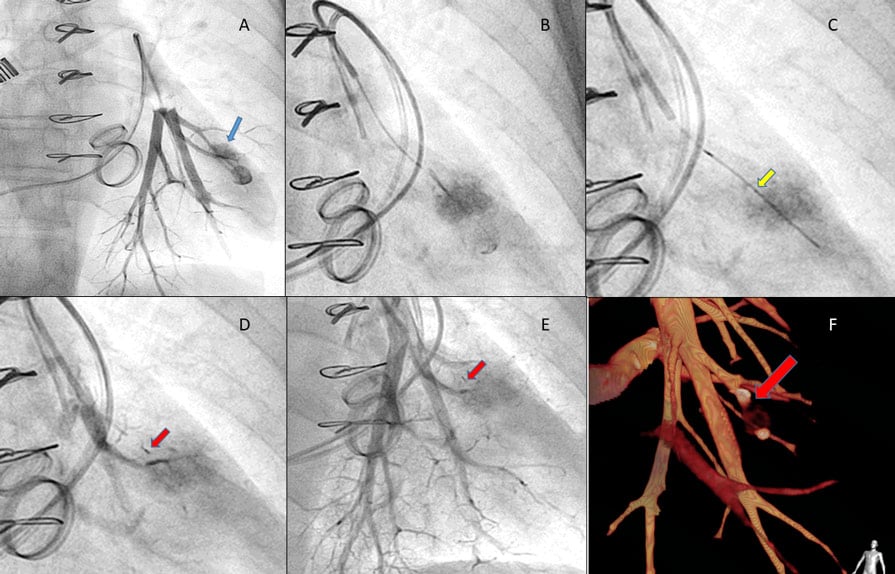Repair of iatrogenic perforation of a pulmonary artery side branch with Micro Vascular Plug System
Supported by the EuroIntervention Journal
Authors1
Ana Pardo, Juan Sánchez Corral, Alejandra González Leal, José Luis Zamorano Gómez and Ángel Sánchez Recalde
Case summary
Catheter-induced pulmonary artery rupture is a rare but often fatal complication of right heart catheterization that is due to catheter placement1.
Treatment of this complication includes emergent intubation, lung resection, surgical pulmonary artery repair, and catheter-based pulmonary artery embolization2,3.
The patient was a 64-year-old woman with a past medical history of aortic and mitral mechanical prostheses and moderate pulmonary hypertension in the last echocardiogram.
Right heart catheterization was performed using a 7 Fr thermodilution catheter (ICU Medical) balloon-tipped catheter. The pulmonary artery pressure was 51/24 mmHg, mean pulmonary capillary wedge pressure 23 mmHg.
The inflation of the balloon in the left inferior branch of the pulmonary artery damaged the branch, causing a perforation of the artery. This was made evident by frank hemoptysis after balloon inflation. However, the patient remained hemodynamically stable, with an increasing need for oxygen (high-flow oxygen mask).
With the thermodilution catheter inflated in the pulmonary artery, an angiogram was performed. It demonstrated the formation of a pseudoaneurysm with extravasation of contrast. The tip of the catheter was inserted in the left pulmonary branch and the balloon was inflated to half its prior volume, creating a tamponade effect and stopping the hemoptysis (Figure 1A, Moving image 1).

Figure 1: Repair of iatrogenic perforation of a pulmonary artery side branch with Micro Vascular Plug System
The balloon was inflated for ten minutes, with periodic deflations, and angiograms were performed through the distal port of the catheter to determine if the rupture would seal, with no success.
At the same time, another vascular access was obtained by the left femoral vein. A multipurpose 6 F catheter was advanced to the damaged branch, and a Terumo Progreat® 2.7 Fr microcatheter was inserted (Figure 1B, Moving images 2,3).
MVP™ Micro Vascular Plug System® Q5 (Medtronic) for peripheral embolization was deployed (Figure 1C) with completed and immediate mechanical occlusion (Figures 1 D, E, red arrow, Moving image 4).
The final angiography demonstrated resolution and clotting of the affected pulmonary artery pseudoaneurysm. The adjacent pulmonary artery remained free from injury.
A computed tomography scan performed 3 days later demonstrated no acute bleeding, a small hematoma in the left inferior pulmonary lobe, with the perforation completely sealed (Figure 1F).
Pulmonary artery rupture during right catheterization is a serious complication that needs to be solved urgently. The patient can be stabilized by tamponade of the pulmonary artery with the catheter balloon tip. Micro Vascular Plug System® for peripheral embolization is a safe and quick option for this feared complication.
References
- Poplausky MR, Rozenblit G, Rundback JH, Crea G, Maddineni S, Leonardo R. Swan-Ganz catheter-induced pulmonary artery pseudoaneurysm formation: three case reports and a review of the literature. Chest. 2001 Dec;120(6):2105–11.
- Leick J, Leinen S, Friedrich I, Werner N. Iatrogenic perforation of a pulmonary artery side branch-a case report. Vol. 5, European heart journal. Case reports. 2021. p. ytab199.
- Dobies DR, Cohoon AL, Bates AA. Images in cardiovascular medicine. Repair of a perforated pulmonary artery due to a Swan-Ganz catheter using thrombin injection. Circulation. 2009 May;119(17):e521-2.
Affiliations
- Hospital Universitario Ramon y Cajal, Madrid, Spain
Conflict of interest statement
The authors do not have any conflict of interest to declare.




No comments yet!